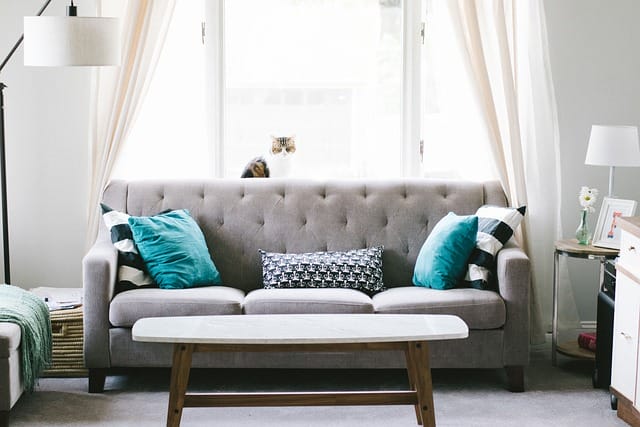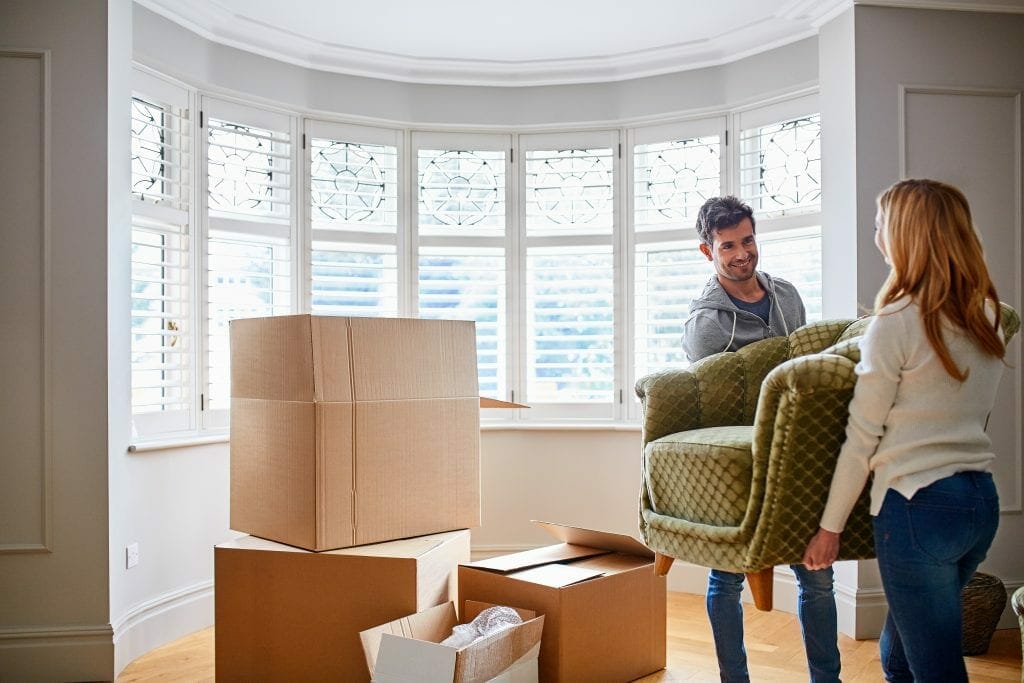Storing.com can supply you with professional storage boxes in a variety of shapes and sizes, including hanging wardrobe boxes, to ensure your precious possessions are safe during transit and in storage. We also supply various packaging materials including bubble wrap, soft furnishing covers, packing tape, tissue sheets and marker pens.
Our expert packing tips at a glance
- The most important consideration when packing delicate, fragile and breakable items is the selection of suitable storage boxes. There is no point in carefully wrapping items if the box is too flimsy to hold them safely.
- Always wrap fragile items like plates, saucers, china, cups, bowls, glassware and crystal individually first and then place in the box. Place larger items, rim down, on a crumpled paper base, in the bottom of a box with a further layer of cushioning above them.
- Stack plates and flat crockery items on their edge, never flat, as a middle layer. Then cups and glasses, wrapped in tissue paper, rim down, as the top layer. Put good cushioning, preferably thick card or crumpled paper, between each layer.
- Never put cups, glasses, bowls, vases etc inside each other. Be careful using old newspapers as the ink can come off onto china and glass and is sometimes difficult to remove. Unprinted ‘newsprint’ is the better choice. Always fill each box almost to the top, finishing with packing material, and pad the insides to ensure there is no movement of the contents.
- Large items such as lamps, hats, artificial flowers, ornaments, small electrical and entertainment items, need to be packed individually in bubble wrap and placed in the appropriate sized box.
- Televisions and large electrical goods should be treated as furniture and handled by our transport team.
- Mirrors, glass tops and pictures should have the glass protected by thick card and then each item packed in bubble wrap.
- Seal each box with packaging tape and write a general description of the contents in the space provided using a bold marker pen, including whether the items are fragile.
- To ensure safe handling of Books/Magazines and paperwork, we recommend box SDC-014a 18 x 18 x 10 inches (or your own box of a similar size). When full this will be a maximum weight of 20 kg, which is a weight safe for manual handling.
8 Crockery Packing Tips
These 8 expert packing tips will keep your crockery in one piece.
Moving home comes with all kinds of stresses and considerations. There’s a lot to think about isn’t there? Whilst we can’t fix everything on your moving list, we do have some handy tips on keeping your crockery intact. Crockery has a nasty habit of getting broken in transit, and nobody wants to start a day in a new home with a box of broken plates.
To help keep your crockery in great shape for your move, take a look at these 8 expert tips:
1. Use The Right Boxes
It is important not to use bags when you pack your crockery as they won’t be properly protected. Instead, it is better to use thick packing boxes which are available from your cheap self storage facility. If you don’t use cheap self storage yet, you could get thick boxes from your local supermarket. Banana boxes are ideal as they often come with lids. Strong, thick boxes will be strong enough to keep your crockery safe without falling through when they are picked up.
2. Ensure Your Crockery Is Clean
It is important to only pack clean and dry crockery. Any debris and moisture may stain and damage your plates, particularly if it will be in your cheap self storage unit for a long time before being unpacked.
3. Cushion Your Crockery
Before you put your crockery into the box you should line the box with some extra padding. Ideally, the padding will be something like bubble wrap. However, some scrunched carrier bags or newspaper will also work well.
4. Wrap Each Plate Individually
Each plate should be wrapped individually with something like acid-free paper which will help avoid moisture build-up. Newspaper will work but you do then run the risk of the print coming off on the items.
5. Pack Plates On Their Side
You might naturally pack plates with their bottom on the bottom of the box. It is actually better to lay them on their side, which makes them more durable to damage.
6. Don’t Leave Any Gaps
It is so important not to leave any gaps in the box which would allow the crockery to move around. Stuff paper, bags or any dry material into the gaps to ensure everything is held in place.
7. Tape, Tape, Tape
It is important to tape the box up really well once it has been packed. Use packing tape and ensure that the whole box is taped up, not just the top seam. This will add strength to the entire box and protect the contents from falling out.
8. Label Your Boxes
Your boxes should be labelled well to indicate that they hold fragile crockery. Don’t be afraid of over-labelling the box. It can never hurt to shout too loudly that a box has fragile contents. This is especially true if you won’t be overseeing every item being moved and relocated.
With our 8 tips above your crockery will get to your self storage unit, or new home, in fantastic shape.
Preparing Your Sofa For Storage
Sofas and other soft furnishings are expensive and putting them into storage can be worrying if you don’t protect them properly. Here we look at how to ensure your sofas and other soft furnishings come out of storage the way they went in.
The love of our lives – the soft, squashy, beautiful, expensive piece of furniture we love to spend as much time on as possible – the sofa.
Sofas can be found in living rooms everywhere in the UK, and across the globe. They can be low and vintage, big, fluffy and squashy, bright floral and fuzzy – they come in all shapes, sizes and styles, and they tend to be the focal point of the living room.
There may come a time when you need to store away your beloved sofa. Perhaps you have had to replace it and you need to store it to make way for the new one, eventually selling the old one when you have time. Maybe you need to store your sofa whilst you redecorate, or you need to store your sofa because it’s too big for your new home, but you aim to upsize again in the future and take your favourite sofa with you.
Whatever your reason for using affordable self storage for your sofa, you’re going to need to store it right. Sofas are not cheap, so it makes sense to take the time to prepare it properly so it doesn’t suffer any damage, and comes back out of storage in the condition it was in when you put it in.
Stage One – First things first….
Make sure you choose the right storage facility. This may seem obvious, but, if you don’t have much time or you’re on a tight budget it would make sense to jump at the first place you can afford. This would be a mistake, though.
If they don’t have the best security your unit could be broken into, and even with the best possible insurance, there’s no replacing sentimental items, or items that are no longer available to buy.
If the temperatures aren’t controlled, temperature extremes could affect the sofa. Wood, which makes the frame of most sofas, swells and shrinks with extreme temperatures and over time warps the shape of the wood.
If the unit is not well maintained it could be damp. Damp could result in your sofa going mouldy and smelling of mildew, eventually, with no attention, completely degrading and rotting.
If there isn’t vermin control, you may end up getting your sofa back with some added furry friends you didn’t ask for. Even if those new squeaky pals don’t make a permanent home, their gnawing and nesting will ultimately damage your sofa. Naturally, you may also be hesitant to even want to keep a sofa that has been utilised by rats and mice.
All of these issues are avoidable if you choose the right self storage unit, which might take a little bit of time, but ultimately – your sofa is worth more than a quick, badly thought out decision to store in an unsuitable facility. Make sure you take your time to do your research and choose a facility with:
- Great security
- Affordable but fair prices
- Good hygiene
- Climate control
- Friendly staff
- Attention to detail
Stage 2 – Preparing Your Sofa For Self-Storage
Of course, it doesn’t matter if you use the best storage facility known to man, if you don’t prepare your sofa properly, it’s not going to come out in the best condition.
The first step will be cleaning the sofa. This is so important as it ensures your sofa is protected from being damaged by mould, mildew, dirt and debris already present on or in the sofa. There’s no room for pride here – these kinds of issues can hide inside sofas and we wouldn’t necessarily know they are present or an issue. Once in storage, though, there is room for the smallest issue to get bigger and bigger until some really bad damage is done to the furniture. Mould and mildew spores can also spread to other items in the unit. So if your sofa does start to rot, the spores from the mould and mildew can and will spread to other soft furnishings, furniture and clothes and impact them. First, causing them to smell and staining them with grey, black and white spots, then eventually rotting the material altogether.
Knowing that a small tarnish when a sofa is stored, could rot the sofa completely if it is left to develop in a different environment that may encourage it to go mouldy or to weaken the material, means anticipating an issue and preventing it. Assume the worst to ensure the very best possible storage results.
Before you clean the sofa fully, be sure to take all the cushions off and vacuum, removing any crumbs and other debris like coins and toys, as they can cause damage if left inside the sofa.
When you start to consider cleaning the furniture you must research the type of material you are working with and look at the manufacturer’s instructions. Cleaning the sofa incorrectly could damage it permanently, so it is extremely important to take the time to research how to do it right. Leather, cotton, linen, wool and silk all have very different instructions for cleaning. The materials that give the sofa its structure may also have different cleaning directions compared to the cushions or upholstery.
If you are at any point unsure about how to clean your sofa, or you are worried about your ability to do it yourself – invest in expert advice. There’s nothing wrong with paying someone to do the work for you if it means the job is done right.
When you have cleaned the sofa or had it cleaned, you will then need to cover it over. The priority is to ensure that it is not wet at all.
If the sofa has been cleaned and isn’t completely dry you will get bad smells, mould and mildew which will damage your sofa while it is in storage, as we mentioned above. As we also mentioned, it may also damage other items in storage. Even if you feel sure the sofa is dry, allow it to air dry for longer just in case – it really is better to be safe than sorry.
When you are sure it is dry, you can then place a cover on it. Do not opt for a plastic cover – this is almost always a bad idea, even with brand new sofas. It is not breathable, and if any moisture at all is present, condensation will occur and cause huge problems. Usually, breathable sheets and other materials make more sense and will adequately protect the sofa from dust. The only time you should use plastic sheeting is for transportation when it’s raining, so you can avoid soaking the sofa. This plastic should then be removed when you get to the storage unit, so the material is able to breathe.
As part of the protection process, it might also be worth placing protection on the corners (padding), and around the wheels, so you can protect potential damage from moving the sofa around. Another way to help protect the sofa during moving is to place padding on any corners or parts of the home where you anticipate that there will be bashes or scrapes as you get the sofa out. Door Frames, stair posts – anything where the sofa has to be carefully negotiated around those items. Wrapping some padding around those items will help protect them and the sofa as you negotiate it out of your house.
Furthermore, ensuring everybody moving the sofa knows how to handle it properly will help keep it (and the movers) protected. If you’re not sure you’re able to do it yourself with your partner or friends, do speak to a professional moving company who will have experience getting the job done safely.
Stage 3 – Placing The Sofa In Storage
You need to think carefully when you place the sofa in your storage facility. Some people choose to store their sofa upside down or on the side – we recommend storing it as it sits in your living room. We also recommend you do not place boxes or any items on top of it if possible as these will strain the sofa and may cause long term damage. Ideally the sofa will be able to sit in a space in your unit with room to breathe around it. Obviously, you often do have to use every inch of the storage unit, but if you are able to have space around the sofa so it isn’t completely packed in, that will help with airflow.
How To Pack and Store Technology Properly
Here we look at how to pack and store technology properly ensuring it remains undamaged and is stored in the best possible way.
Technology is something most of us prioritise over other household possessions. This is for a number of reasons including the fact it costs so much, and we interact with it more than anything else. Sometimes, we may need to store our technology. Perhaps it is safer to store it whilst going on holiday, or travelling than leaving it in a house. Perhaps you are a university student who needs somewhere to store tech between semesters. Maybe you collect vintage or unusual technology and use self storage for your hobby.
Whatever your reason for storing technology, one thing is clear, you need to store it right. Electronics are extremely sensitive. They have lots of components and are extremely dynamic in the way they function. Although some technology might be OK in a box with no special care, lots of other items won’t fare so well. The climate and humidity in the self storage environment is a particularly important factor to consider.
To help you care for your technology well whilst it is in self storage, we have compiled these useful tips on the subject.
ALWAYS-LOW COSTS
See how much you can save on self storage costs
COMPARE PRICES
So here are our expert tips to help you prepare your tech for storage:
Back It Up
All electronics should be backed up before you store them. Any that have a memory or server must be backed up. This means you have the data ready to access yourself, and you have it just in case the device does not start up again after storage, or it gets damaged in transit. With family photos, sentimental documents and scanned documents, you really cannot risk losing them.
Data Security
With the right self storage, you have no reason to worry about climate control, environmental factors or theft. You do have to have insurance of your items whilst they are in storage. However, that doesn’t mean you shouldn’t prepare for the worst when it comes to data security. In any worst case scenario, however unlikely it may be, your personal data could be stolen or taken by someone else. This could be detrimental to you. Sensitive information, financial information, passwords – the list is endless. Make sure you either remove sensitive information from your devices completely (after backing them up) or you protect them using encryption.
Component Protection
Tech contains lots of bits and pieces which form part of the device as a whole, and all the pieces that might go with the item, like the charger, headphones, controllers etc. Where possible if an item can be stored separately it should be. Plugs especially should be protected and stored separately if possible. Any memory cards, CD’s, DVD’s, covers, lights and additional extra’s should be removed and stored separately.
Clean Well Before Storing
 Before you store your items, clean them properly. Use a compressed air gadget to clean out your items, as dust and debris can cause a lot of damage to electronics over time, and it’s amazing how many crumbs can end up in the gaps in your keyboard, especially if you like eating while you’re browsing the internet or working. You might also want to give items a dry wipe down (or using polish if applicable) so they are clean before storage.
Before you store your items, clean them properly. Use a compressed air gadget to clean out your items, as dust and debris can cause a lot of damage to electronics over time, and it’s amazing how many crumbs can end up in the gaps in your keyboard, especially if you like eating while you’re browsing the internet or working. You might also want to give items a dry wipe down (or using polish if applicable) so they are clean before storage.
Cover Everything
Do not leave electronics or technology gadgets and devices out in the open in your unit. No matter how clean it is, there will be dust and that dust will settle onto and into every item that is not adequately protected. You’re unlikely to have the original packaging, but if you do, use that. Alternatively wrap items in a breathable cloth or padding and then place in a sturdy box labelled ‘breakable’ or ‘handle with care’. You should never store your item in plastic because that will likely lead to moisture build up which will damage your item.
Consider Climate Control
Lots of different climate issues will affect your tech over time, so it is important to ensure the climate is right. Wind or draughts will bring particles through to the equipment building up and causing damage. Heat will warp plastic, ruin batteries and damage components. Humidity can either cause excess static discharge or condensation depending on the levels. Cold will cause issues with the components of the device. For valuable tech equipment it, therefore, makes sense to consider a climate controlled unit.
Follow Specialist Instructions
If you have specialist tech or equipment it is extremely important you store it correctly. Look for specialist advice on how to take the item apart and store it. It would not be pleasant to store the item incorrectly and see its value decreased massively because of damage that could have been avoided.
Label Everything
 One thing many people forget when storing electronics is labelling. Labelling is particularly important when it comes to electronics and tech, because there are so many different parts. If you can store everything in the same box (wrapped separately) that is ideal, then you can label the box with a number or word, then write down the box contents in your log book. You might even want to draw a rough diagram of each part and what it is for. Always allow for misplacement during transit or times when you need to shift things around in the unit.
One thing many people forget when storing electronics is labelling. Labelling is particularly important when it comes to electronics and tech, because there are so many different parts. If you can store everything in the same box (wrapped separately) that is ideal, then you can label the box with a number or word, then write down the box contents in your log book. You might even want to draw a rough diagram of each part and what it is for. Always allow for misplacement during transit or times when you need to shift things around in the unit.
Consider Placement In The Unit
Don’t forget to think carefully about where you place the item in the unit. Placing it on top of unstable items might well cause the item to fall off and break. Placing it underneath heavy items might cause it to become crushed (this can happen slowly over time). Make sure the item is fully secured and placed in the unit where it can be clearly seen, isn’t getting crushed and isn’t liable to become unsteady.
Packing and Storing Awkward Items
Not all items that need to be packed into a self-storage unit are regularly shaped. Many such as sports equipment need to be carefully packed to avoid damage.
 Whether you are packing up the complete contents of your home, seasonal items, business stock or just clutter you cannot bear to part with in order to place them in storage there are bound to be some awkward items that will need special care and attention or are difficult to pack and protect well. These are the items that need to be packed carefully if they are to survive their stint in storage unscathed. You might be storing your possessions long-term (while you live temporarily overseas for example) or just as a temporary measure between house moves, but no matter how long or short the storage period is, items can always get damaged if they are badly packed or badly stacked in the storage unit.
Whether you are packing up the complete contents of your home, seasonal items, business stock or just clutter you cannot bear to part with in order to place them in storage there are bound to be some awkward items that will need special care and attention or are difficult to pack and protect well. These are the items that need to be packed carefully if they are to survive their stint in storage unscathed. You might be storing your possessions long-term (while you live temporarily overseas for example) or just as a temporary measure between house moves, but no matter how long or short the storage period is, items can always get damaged if they are badly packed or badly stacked in the storage unit.
So here are some useful tips for packing some of the most common awkwardly shaped items so you can improve the chances of your items remaining in good condition.
Packing Computers
There are many reasons why you might wish to store a computer – a business PC may currently be surplus to requirements but you anticipate needing it again in a few months’ time, and, whilst, computers and their operating systems and software do quickly become out of date, even old computers can be useful for standard use such as word processing and spreadsheets. Or you may run a computer repair business and need to store computers that could be useful in the future for their spare parts. But whatever the reason it will need to be packed carefully to avoid damage in transit or once in storage.
Once the computer has been shutdown, unplug it and all its peripheral devices such as the monitor, printer, speakers, external hard drive, keyboard etc. so that each item can be wrapped separately. If you are fortunate enough to have any of the original boxes then use those, otherwise use plenty of bubble wrap securely taped around each component and then place each parcel in its own box with additional bubble wrap or old newspaper used to fill the gaps in the box. Always use strong cardboard packing boxes and never be tempted to use the fragile boxes that can be picked up for free at most supermarkets – these are simply too flimsy to give valuable or fragile items the protection they need during transportation and once in storage.
Packing Bicycles
Many bicycles are highly valuable and if not protected adequately their gears, in particular, can be easily damaged. It is impractical to wrap a bike in bubble wrap (not to mention expensive) so find a large packing box or try to buy a specialist bike box in your local bike shop – these are inexpensive but effective at protecting a bike in long-term storage.
Before placing a bicycle in self-storage bedford remove the tyres and let the air out then remove the handle bars and mud guards not forgetting to put the screws in a bag to keep them together for when you come to use the bike again. Put the frame, wheels and handle bars in your packing box using old newspaper between each item to prevent scratching and other damage.
How To Carry Heavy Items Safely
Now that you’ve learnt some tips and tricks to help you pack everything properly, here’s how to protect your physical health when you’re moving heavy items around.
Renovating, decorating, filling a self storage unit or even just moving things around is all well and good for personal progress, until you hurt yourself moving something heavy.
Moving bulky items without the right techniques could cause you some permanent damage, expensive physio or chiropractor appointments, and lots of avoidable pain in the future.
To stay injury free when you’re next relocating anything heavy, take a look at these important tips on how to carry heavy items safely:
Prepare, Prepare, Prepare
One of the best ways to avoid injury is to prepare. So rather than last minute rushing to move a big item, get a friend to come over and help you move it safely, prepare a trolley to move it or get a moving crew booked to help you get the item from A to B. At the very least, have the right kind of clothing on or allow enough time to physically move the item in the safest possible way.
Maintain The Right Posture
The way that you move an item makes a huge difference to whether or not you are at risk of sustaining an injury when you do it. You can find some tips for safe lifting on this handy NHS page.
Use Specialist Equipment
Lots of self storage units will have different tools you can use to help safely move large items around. Stair rollers, forklift trolleys, cage trolley and lifting straps are all useful in moving heavy items safely.
Create A Path
Creating a path for the item to move from A to B may sound a bit strange, but actually, it can be vital to safely moving something. For example: if it takes your whole strength to lift the item and you then walk a few steps to find the door is closed, you may strain to open the door holding the item, have to go all the way back to the start to put it down, or even be stuck with the item and a closed door and no way to move. Or you walk with the item and don’t account for a wonky bit of path that without care, is a trip hazard. Plan the items journey to ensure it is unobstructed and safe.
Moving Heavy Items Into Storage
If you’re moving heavy items into self storage, do consider enlisting the help of a professional moving team. They will know how to lift heavy items safely, saving you the risk of injury. Remember, here at Storing.com we offer FREE collection if you’re storing for 6 months or more. At the very least, speak to us about how else we can help you move your heavy items more easily and safely.
Prohibited items
Prohibited items include drugs, pornographic material and potentially dangerous, damaging or explosive items, including gas bottles, aerosols, paints, firearms and ammunition. If items such as these are suspected to be contained within a storage unit, the police have the legal right to access the unit.
Find out more about what can’t be stored in self-storage units







